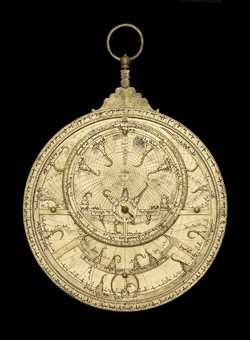| Date | 1733/4 (A.H. 1146) |
| Maker | Muḥammad ibn Aḥmad al-Baṭṭuṭī |
| Place | Morocco |
| Material | Brass |
| Inventory no. | 51459 |
| Acquisition | Presented by J. A. Billmeir in 1957 |
That the astrolabe in the Islamic world carried religious significance need hardly be stressed. It was frequently embellished with verses from the Qur’an or other devout phrases. The much-quoted surah 2:255 includes the most apt lines ‘All things in heaven and on earth belong to Him [God]’ and ‘His throne extends over the heavens and the earth’. The passage was frequently inscribed in full on the ‘throne’ of the astrolabe.
If the astrolabe was seen as capable of bridging the gap between the mundane and religious worlds, two instruments in the collection exemplify a very special way for it to do so. This instrument by al-Baṭṭuṭī is inscribed as having been ‘given as a bequest’ to the minaret of Idrīs at Fez, Morocco, that is, to a mosque. The other (inventory no. 34314) was similarly bequeathed to the mosque at Tangier, perhaps by a wealthy merchant.
The phrase probably means not that the worshipper left his own, used astrolabe to his mosque, but rather that he left funds for a particularly fine astrolabe to be specially made. To underline one of its sacred functions, in determining prayer times by true astronomical time, this astrolabe contains special lines for the calculation of Muslim prayer times.
View all
images for this astrolabe
View
detailed provenance for this astrolabe
Mater
The mater and limb are of two pieces, soldered and riveted construction. The notch for holding the tympans in place is located at the throne.. Scales on the limb: degree scale. More informationBack
The back contains 7 scales of the following types: Altitude; Zodiacal signs; Calendar; Sine/Cosine; Unequal hours; Shadow square. The back is inscribed: with a donation marked as الحمد لله حبّس الرئيس الجليل الماجد الحفيل الفقيه الأجل سيدي محمد بن المرحوم بكرم الله تعالى القائم على ما ينبغي (؟) هذا الأصطرلاب على منار مولانا إدريس نفع الله به الذي بالحضرة الفاسية (Praise be to God. My master, the great, glorious, eager ruler, the greatest jurist, Muḥammad, son of the deceased, may God the Exalted have mercy with him, He, who establishes what is right (?), gave this astrolabe as a bequest to the minaret of our master Idrīs, may God make use of him (for the benefit of others), which is in Fez.). Inscription within hour-line diagram. More informationRete, Pin & Wedge
The rete contains 26 stars. The zodiac on the rete is labelled: الحمل , الثور , الجوزا , السرطان , الاسد , السنبله , الميزان , العقرب , القوس , الجدي , الدلو , الحوت .The rete is attached using a pin & wedge. The pin is quite long, and may not be original. The wedge is an elaborately carved piece, not uncommon on maghribi astrolabes.. More information
Rules & Alidades
| Type | Details |
|---|---|
| Alidade | Double-ended, which is fixed and imovable. The rule
is not original. There is some decorative scroll work
close to the pivot hole on this alidade.. |



